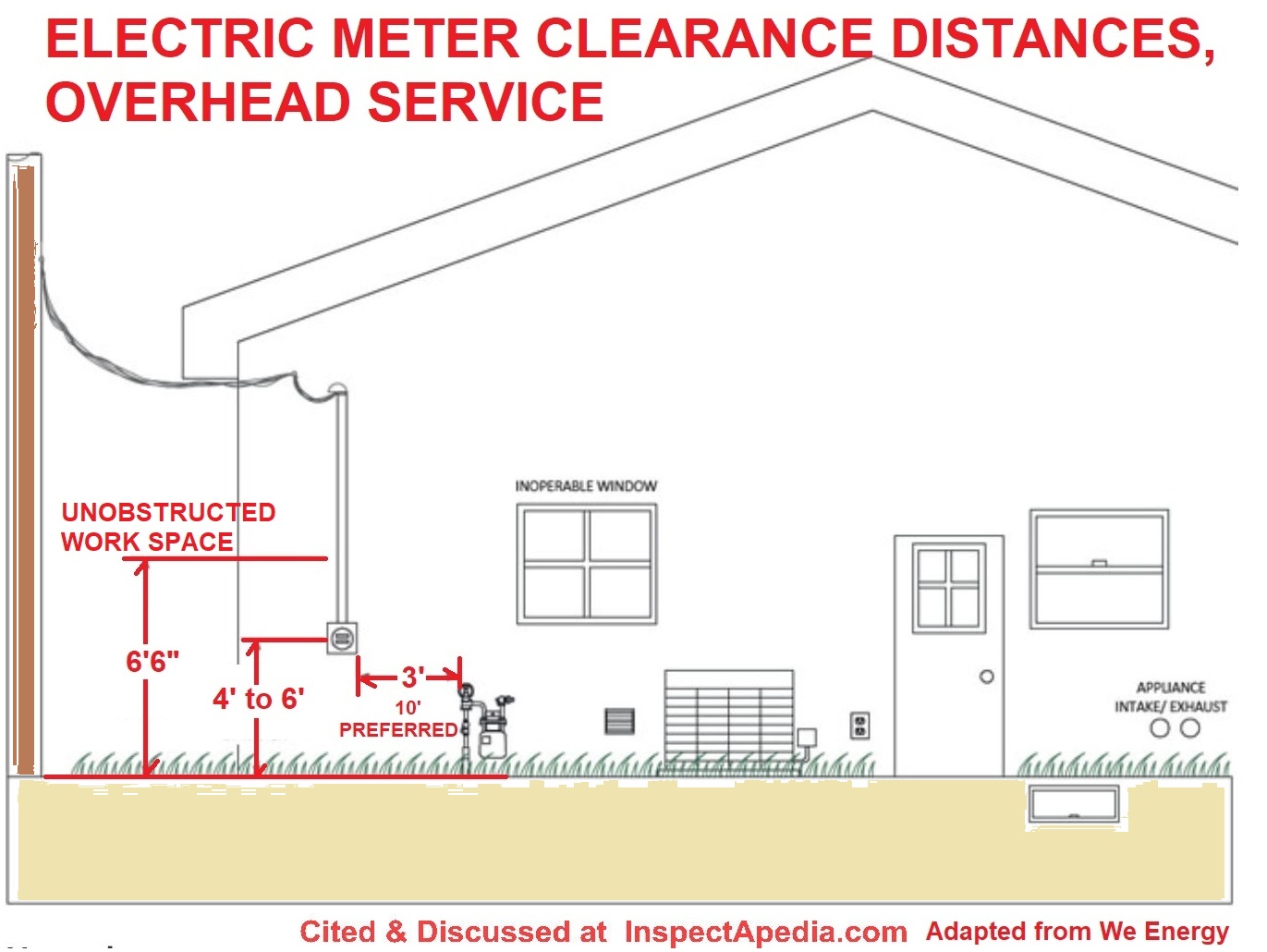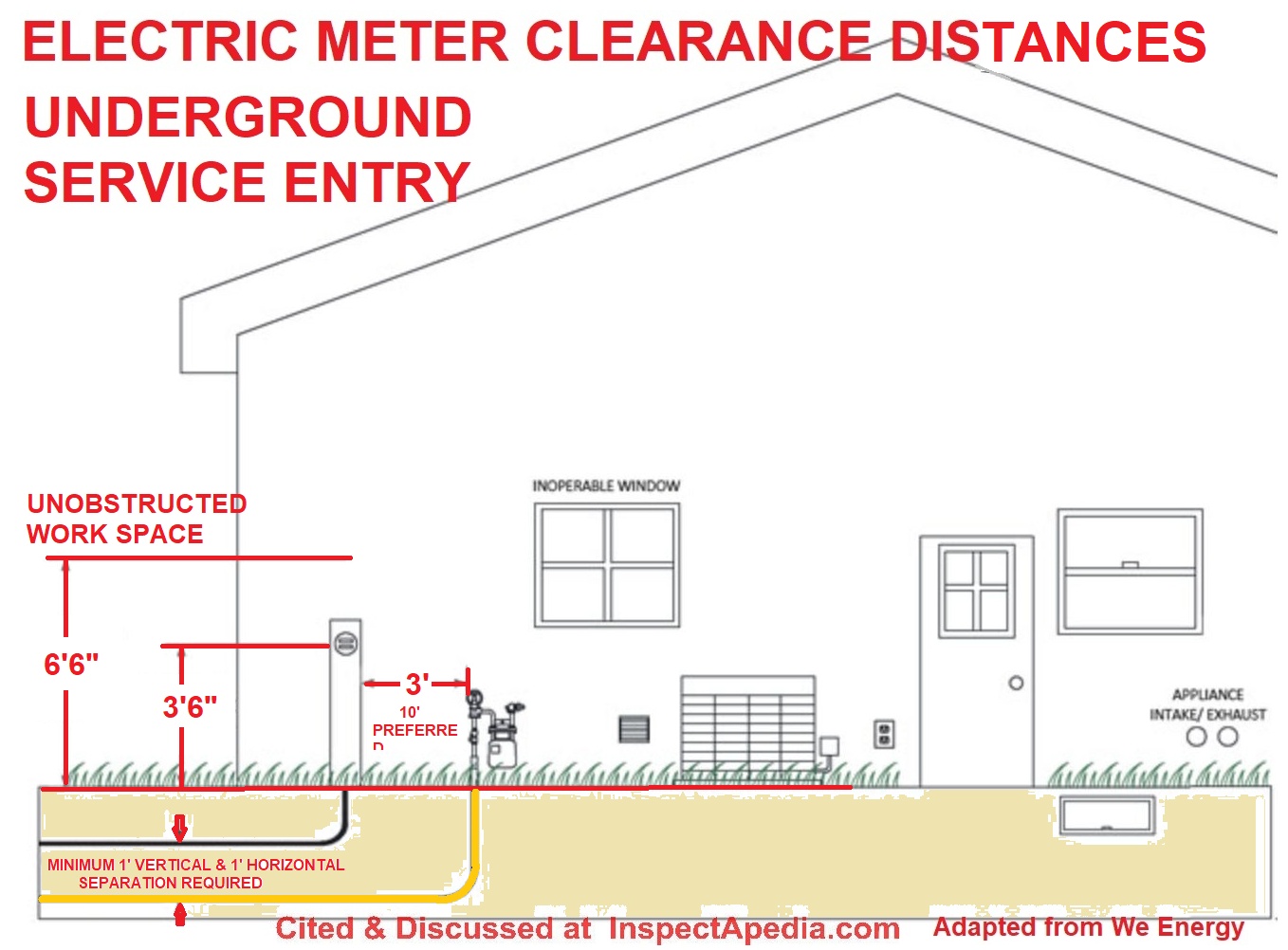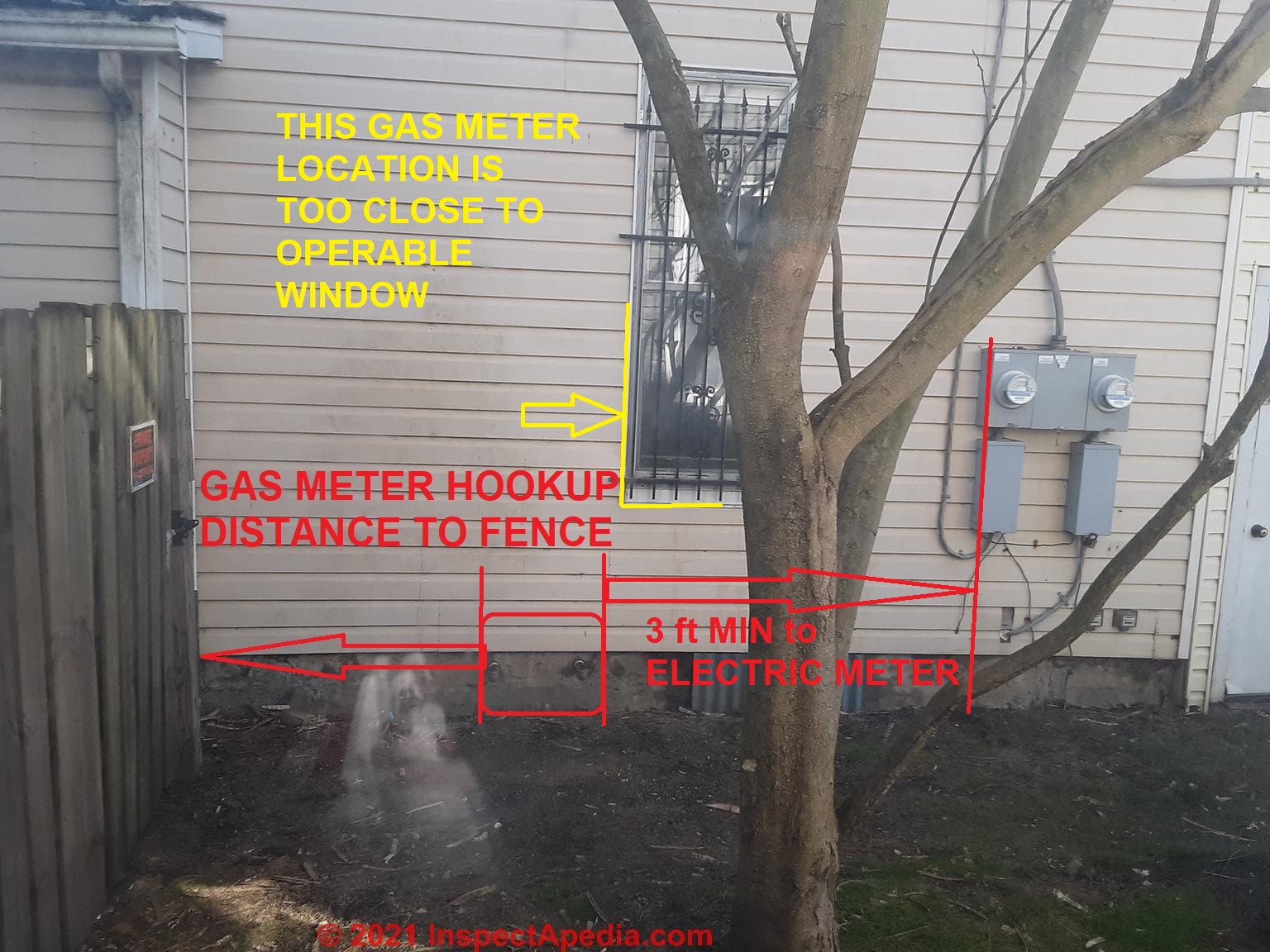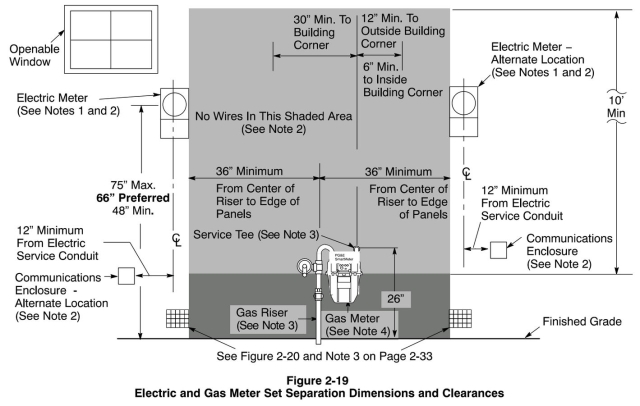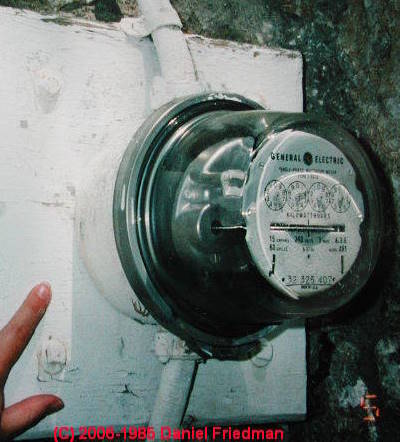 Electric Meter Clearance Distances
Electric Meter Clearance Distances
Electric Meter
Working Space Requirements & Codes
- POST a QUESTION or COMMENT about inspecting, installing, replacing residential electric meters
Electric meter inspection & repair:
This article discusses the visual inspection of electrical meters & meter bases & explains how to estimate the electrical service size, (or "electrical power" or "service amps") at a building by visual examination of the service entry cables, electric meter and meter base, electrical service panel, main switch, & other details.
We describe types of electric meters, meter inspection points, and how to read an electric meter. We also discuss electrical arc burns at the meter base and we include case reports of electric meter base overheat and arcing damage, failures, and repairs.
InspectAPedia tolerates no conflicts of interest. We have no relationship with advertisers, products, or services discussed at this website.
- Daniel Friedman, Publisher/Editor/Author - See WHO ARE WE?
Electric Meter & Meter Base Clearance Distance & Working Space
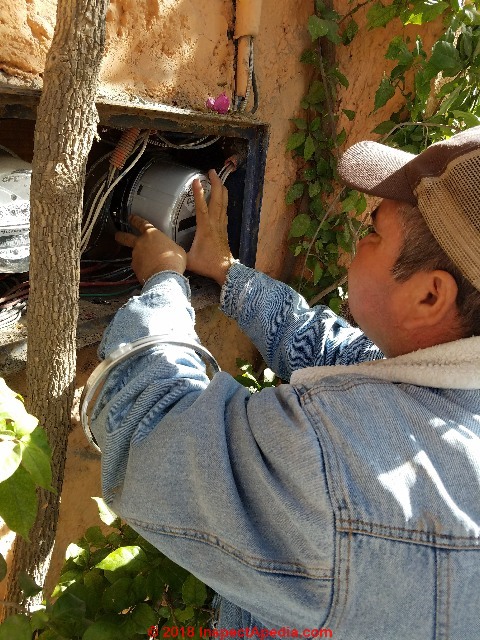 Here we give details of the space required in front of, above, and at either side of electric meters for both overhead and underground electrical service installations a buildings.
Here we give details of the space required in front of, above, and at either side of electric meters for both overhead and underground electrical service installations a buildings.
These electric meter clearance distances are necessary for safety in accessing or working on the electric meter and also to reduce the risk of fire or, if near gas equipment, an explosion.
A building owner or occupant also needs safe access to the electric meter simply to check its reading of electricity consumption.
In an emergency a worker may also want pull off the electric meter in order to stop all electrical power entering the Building without having to enter a building that might be safe such as due to a fire, flooding, or an earthquake.
Watch out: the step of pulling an electric meter or opening the meter base should be performed by a licensed electrician. It is not within the scope of a visual home inspection nor that of a homeowner.
Doing so risks shock or death by electrocution.
Article Contents
- ELECTRIC METER CLEARANCE DISTANCES & WORKING SPACE REQUIREMENTS
- ELECTRIC METER CLEARANCE CODES & REGULATIONS
Photo: in San Miguel de Allende, Mexico, a CFE electric utility employee is removing the electric meter to inspect the cause of a burn-up and loss of electrical power.
Notice that the worker's arm is blocked by a tree branch.
Not shown in the photo was the difficulty faced by the worker in removing a security cover over the electric meters (preventing theft of the whole meter itself).
The scope of a building inspector's responsibility is similar to but may even go beyond that of the electrical contractor and the local electric utility in that she must observe and report visual evidence of unsafe or expensive defects and conditions as part of a public trust.
Because of this, the visual inspection of the meter and meter base is an important part of your electrical system inspection, and must be done carefully.
For home inspectors, this will help to protect your client's interests and will help fully inform them about electrical system defects and the proper service ampacity of the house they occupy or that they are planning to buy.
Electric Meter Clearance Distances & Working Space
The sketches of electric meter clearance shown here are adapted from We Energies cited below. Above are the requirements for unobstructed working space around an electric meter when the electrical service is provided by overhead wiring.
Below are similar, but not identical, working space and clearance distances for an electric meter fed by an underground service entry cable.
Here is a summary of the space requirements around electric meters.
- Three feet of unobstructed working space
is required around both electric meters and gas meters.
That distance must be measured from the meter face and both towards all sides of the meter and in front of the meter itself. - Electric meter working space height - 6'6" total height of clearance space:
There should be unobstructed workspace in front of the meter extending from the ground to 6' 6" above the ground.
PG&E cited below gives a 75" Maximum height, 66" (6'6") preferred working space height. - Electric meter should be 4' to 6' above grade:
The electric meter face center should be 4' to 6' above the finished grade. - Electric meter 3 ft or 10ft from gas meter:
Typical electric company meter installation guides will also require at least 10' of clearance between the electric meter and the natural gas meter assembly "in the cases of source of ignition and air intakes including doors and windows", though where that's not practical, some companies may permit that clearance to be reduced to as little as 3 ft. - Meter Should Not be: below dripping condensate or water:
The electric meter should not be located where dripping condensate such as from an exhaust vent might fall onto the meter - Your local electric utility supplier is the first authority you should consult for questions about electric meter clearance distances.
Electric meter installation requirements including working space or clearance distances are usually given by utility companies,often combined with gas meter specifications as well.
And where electric meters and electric service panels, main panels, or distribution panels are adjacent, the electrical meter is allowed to protrude into the working space up to a maximum of 6 in. (150 mm) . The width of that working space must be EITHER the width of the equipment OR 30" - whichever is GREATER.
You'll see that some electric utility companies such as PG&E have different preferred working spaces, as we illustrate below among our references.
Electric Meter Clearance Distance Codes, Standards, Installation Instructions
Above: this gas meter and electric meter location layout is discussed further
at GAS METER CODES & CLEARANCE DISTANCES
- BGE GAS & ELECTRIC INSTALLATION SPECIFICATIONS [PDF] BGE, Baltimore Gas & Electric Co.
- National Fuel Gas Code (NFPA 54)
- NSTAR GAS & ELECTRIC INSTALLATION REQUIREMENTS [PDF] NSTAR
- PG&E, ELECTRIC & GAS SERVICE REQUIREMENTS [PDF] (2017-2018, TD-7001M, GREENBOOK, Gas meter & electric meter installation manual, Website: www.pge.com/greenbook
- PG&E, GAS DESIGN & GAS METER LOCATIONS [PDF], (2013), Pacific Gas & Electric Company
- PG&ELECTRIC & GAS METER CLEARANCES [PDF] and electric service requirements
- PG&E GREEN BOOK ELECTRIC & GAS SERVICE REQUIREMENTS (TD-7001M) 2020–2021 [PDF] original source: www.pge.com/pge_global/common/pdfs/services/building-and-renovation/greenbook-manual-online/greenbook_manual_full.pdf - illustrated just below.
- We Energies, ELECTRIC METER INSTALLATION GUIDELINES [PDF] We Energies, PO Box 6042 Carol Stream, IL 60197-6042 USA Tel: 800-662-4797 - retrieved 2023/05/07, original source: we-energies.com/partners/builders/meter-installation-guidelines
- Also see ELECTRIC PANEL WORKING SPACE
...
Continue reading at ELECTRIC METER OVERHEAT AL to CU WIRING or select a topic from the closely-related articles below, or see the complete ARTICLE INDEX.
Or see ELECTRIC METER & METER BASE FAQs - questions & answers posted originally at the end of this article.
Or see these
Recommended Articles
- AMPS VOLTS DETERMINATION - home
- ELECTRIC METER & SEC SAFETY - Watch out -
- ELECTRIC METERS & METER BASES
- ELECTRIC METER BASE vs SERVICE AMPS
- ELECTRIC METER RATING vs SERVICE AMPS
- HOW TO INSPECT ELECTRIC METERS & BASES
- ELECTRIC METER CLEARANCE DISTANCES & WORKING SPACE
- ELECTRIC METER ARC BURN POWER LOSS
- ELECTRIC METER OVERHEAT AL to CU WIRING
- ELECTRIC METER RUNS BACKWARDS
- FPE ELECTRIC METER BASE & BREAKERS
- SMART or DIGITAL ELECTRIC METER READINGS
- ELECTRIC PANEL WORKING SPACE
- ELECTRIC POWER LOSS / FLICKERING LIGHTS
- ELECTRIC SERVICE ENTRY WIRING & AMPACITY
- ELECTRICAL SYSTEM DEFECTS LIST
- GAS METER CODES & CLEARANCE DISTANCES
- MAIN ELECTRICAL DISCONNECT
- PROTECTION BOLLARDS for MECHANICAL EQUIPMENT
Suggested citation for this web page
ELECTRIC METER CLEARANCE DISTANCES & WORKING SPACE at InspectApedia.com - online encyclopedia of building & environmental inspection, testing, diagnosis, repair, & problem prevention advice.
Or see this
INDEX to RELATED ARTICLES: ARTICLE INDEX to ELECTRICAL INSPECTION & TESTING
Or use the SEARCH BOX found below to Ask a Question or Search InspectApedia
Ask a Question or Search InspectApedia
Try the search box just below, or if you prefer, post a question or comment in the Comments box below and we will respond promptly.
Search the InspectApedia website
Note: appearance of your Comment below may be delayed: if your comment contains an image, photograph, web link, or text that looks to the software as if it might be a web link, your posting will appear after it has been approved by a moderator. Apologies for the delay.
Only one image can be added per comment but you can post as many comments, and therefore images, as you like.
You will not receive a notification when a response to your question has been posted.
Please bookmark this page to make it easy for you to check back for our response.
IF above you see "Comment Form is loading comments..." then COMMENT BOX - countable.ca / bawkbox.com IS NOT WORKING.
In any case you are welcome to send an email directly to us at InspectApedia.com at editor@inspectApedia.com
We'll reply to you directly. Please help us help you by noting, in your email, the URL of the InspectApedia page where you wanted to comment.
Citations & References
In addition to any citations in the article above, a full list is available on request.
- Watt-Hour Meter Maintenance and Testing”, Vol. 3-10, Dec 2000, Facilities Engineering Branch, Denver Office, Denver CO, US Department of the Interior, Bureau of Reclamation, retrieved 8/21/14, original source: www.usbr.gov/power/data/fist/fist3_10/vol3-10.pdf
- Thanks to reader Kirk Schwoebel for discussing electric meter inspection and evidence of arcing and burns at the meter mounting base - January 2011
- Thanks to reader Robert McBride for providing photographs of arcing and burns at electrical meter bases - July 2011
- The Original Authors: Alan Carson is an ASHI Member, national home inspection educator, author and building failures researcher in Toronto, Ontario. Daniel Friedman, an original author of this article and the editor and producer of InspectAPedia where this article now appears is an ASHI Member, first ASHI Technical Committee chairman, editor and publisher of the ASHI Technical Journal, licensed home inspector, educator, and building failures researcher in Poughkeepsie, NY. Robert Klewitz is a licensed professional engineer, a professional home inspector, an ASHI Member, and has served on the ASHI Technical Committee as well as in other ASHI activities. His practice is in Issaquah, WA.
- Douglas Hansen, Robert Stead. Mark Cramer. Photographs: Daniel Friedman.
- N. Srinivasan, MSEE, is a senior member of IEEE with 30 years experience in the electrical industry. Mr. Srinivasan is in Vienna VA.
- Louis P. Babin generously contributed technical editing about the effects of doubling ampacity in an electrical circuit (September 2007)
- "How to Read Electric and Natural Gas Meters", U.S. DOE original source: www.energysavers.gov/your_home/water_heating/index.cfm/mytopic=13120?print
- "Electrical System Inspection Basics," Richard C. Wolcott, ASHI 8th Annual Education Conference, Boston 1985.
- "Electrical System Inspection Basics," Richard C. Wolcott, ASHI 8th Annual Education Conference, Boston 1985.
- "Simplified Electrical Wiring," Sears, Roebuck and Co., 15705 (F5428) Rev. 4-77 1977 [Lots of sketches of older-type service panels.]
- "How to plan and install electric wiring for homes, farms, garages, shops," Montgomery Ward Co., 83-850.
- "Home Wiring Inspection," Roswell W. Ard, Rodale's New Shelter, July/August, 1985 p. 35-40.
- "Evaluating Wiring in Older Minnesota Homes," Agricultural Extension Service, University of Minnesota, St. Paul, Minnesota 55108.
- In addition to citations & references found in this article, see the research citations given at the end of the related articles found at our suggested
CONTINUE READING or RECOMMENDED ARTICLES.
- Carson, Dunlop & Associates Ltd., 120 Carlton Street Suite 407, Toronto ON M5A 4K2. Tel: (416) 964-9415 1-800-268-7070 Email: info@carsondunlop.com. Alan Carson is a past president of ASHI, the American Society of Home Inspectors.
Thanks to Alan Carson and Bob Dunlop, for permission for InspectAPedia to use text excerpts from The HOME REFERENCE BOOK - the Encyclopedia of Homes and to use illustrations from The ILLUSTRATED HOME .
Carson Dunlop Associates provides extensive home inspection education and report writing material. In gratitude we provide links to tsome Carson Dunlop Associates products and services.


